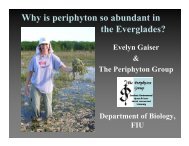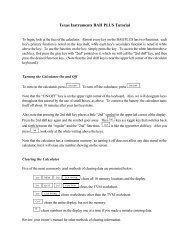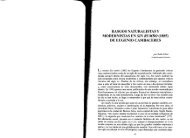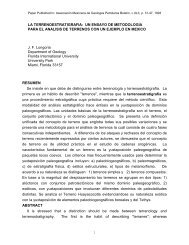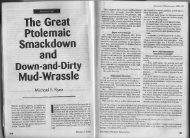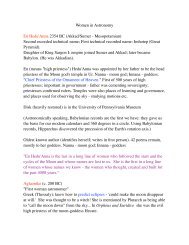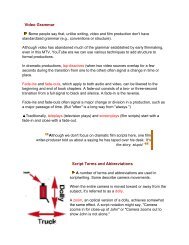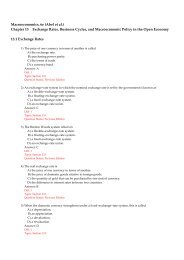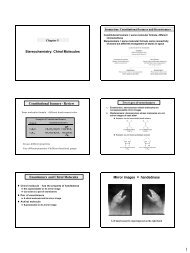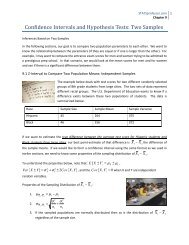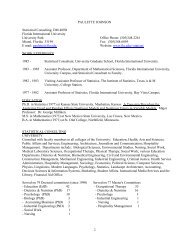Viable Titer and Pure Culture
Viable Titer and Pure Culture
Viable Titer and Pure Culture
- TAGS
- viable
- titer
- culture
- www.fiu.edu
Create successful ePaper yourself
Turn your PDF publications into a flip-book with our unique Google optimized e-Paper software.
milkings. Beef Extract also contains water soluble digest products of all other macromolecules (nucleic<br />
acids, fats, polysaccharides) as well as vitamins <strong>and</strong> trace minerals. Although we know <strong>and</strong> can define<br />
Beef Extract in these terms, each batch can not be chemically defined. There are many media<br />
ingredients which are complex: yeast extract, tryptone, <strong>and</strong> others. The advantage of complex media<br />
is that they support the growth of a wide range of microbes.<br />
Agar is purified from red algae in which it is an accessory polysaccharide (poly-galacturonic acid)<br />
in their cell walls. Agar is added only as a solidification agent. Agar for most purposes has no<br />
nutrient value. Agar dissolves >95 o C <strong>and</strong> solidifies at 45 o C.<br />
M-9 Agar is a chemically defined medium. All the ingredients are chemically defined: the<br />
chemical identity of each ingredient as well as the amount added to the medium is known. M-9 Agar<br />
usually contains glucose as the sole carbon <strong>and</strong> energy source <strong>and</strong> is used by most bacteria growing on<br />
M-9 as the energy source. Ammonium chloride is the nitrogen source <strong>and</strong> magnesium sulfate is the<br />
sulfur <strong>and</strong> magnesium source. The only bacteria that can grow on this medium will be those that can<br />
transport the chemicals into the cells <strong>and</strong> metabolize it to produce energy <strong>and</strong> all the metabolic<br />
intermediates <strong>and</strong> monomers for biosynthesis.<br />
A pure culture is defined as the progeny from one cell. Actually we will be making an axenic<br />
culture from a clone (colony). Assuming that one cell could have given rise to the colony, we call these<br />
pure cultures even though we have no technical proof of that. Proof of pure culture involves showing<br />
that all the colonies on the restreak are identical, <strong>and</strong> Gram staining these to demonstrate all the cells in<br />
the resulting colonies are identical <strong>and</strong> the same as those on the original plate.<br />
Materials per Pair<br />
Lab Session One<br />
1. Four 9ml sterile dilution blanks (16x150 mm capped tube) <strong>and</strong> one 99 ml sterile dilution blank (in a<br />
square bottle)<br />
2. Sterile 1,000 µl pipette tips.<br />
3. 5 Nutrient Agar <strong>and</strong> 5 M-9 Agar plates<br />
4. Sterile 200 µl pipette tips.<br />
5. Balances <strong>and</strong> weighing boats.<br />
6. Glass spreader <strong>and</strong> alcohol in a beaker.<br />
Lab Session Two<br />
1. Gram staining reagents, slides.<br />
2. 1 Nutrient Agar <strong>and</strong> 1 M-9 Agar plates.<br />
Lab Session Three<br />
1. 1 Nutrient Agar Slant<br />
Procedure<br />
Lab Session One - <strong>Viable</strong> <strong>Titer</strong><br />
1. Mark the sterile dilution blanks in the following manner: the 100 ml dilution blank is 10 -2 <strong>and</strong><br />
the tubes sequentially are 10 -3 , 10 -4 , 10 -5 , 10 -6 .<br />
2. Weigh one gram of your sample out in a weigh-boat. Add that gram to the 10 -2 dilution blank<br />
<strong>and</strong> shake vigorously for at least 2 full minutes. Make sure the cap is securely tightened during<br />
the shaking.<br />
3. Allow the 10 -2 dilution to sit for a short period. Then aseptically transfer 1 ml from this dilution<br />
to the 10 -3 tube. The instructor will demonstrate how to make an aseptic transfer. Mix



